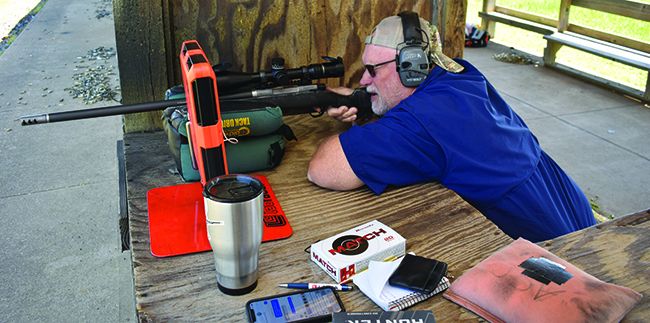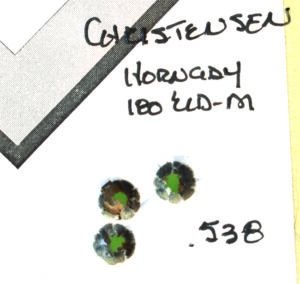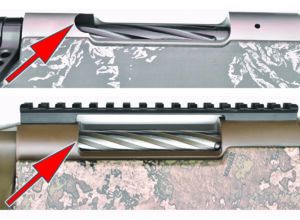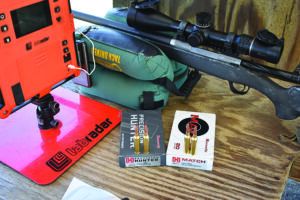
The 6.5 Creedmoor cartridge and rifles chambered for it produce a decent amount of energy without a prohibitive amount of recoil. It seems to be one of those inherently accurate cartridges as well, and it does a decent job of bucking the wind while it stays supersonic and stable long enough to be employed in a longer-range role. All that being said, it is not our favorite round by a long shot. We would like to see something that would throw a heavier bullet faster, and, of course, we don’t want much more recoil or anything that requires a bigger, bulkier action. No problem, right?
Hornady, which designed the 6.5 Creedmoor, or 6.5 CM, apparently thought the same thing, and, in 2018, the company introduced the 6.5 Precision Rifle Cartridge, or 6.5 PRC. It can propel streamlined bullets 5% to 10% heavier and 200 fps faster, delivering substantially more energy along with great ballistics. The 6.5 PRC quickly became one of your most requested reviews and one which we have addressed in three separate articles to date. In 2021, Hornady introduced the 300 PRC, which is essentially a modernized 300 Winchester Magnum. The 6.5 PRC has been a smashing success; the 300 PRC a bit less so.
Then in 2022, Hornady used the same design conventions to update the 7mm Remington Magnum class of cartridges with a new round named, amazingly, the 7 PRC. We wanted to test the new 7 PRC to find out if it was the latest, greatest thing or an incremental improvement on an already very good round. Thinking that proper uses of a rifle chambered in 7 PRC could be for hunting or long-range shooting, we obtained three diverse rifles that we thought would run the gamut of options chambered for the 7 PRC.
- The first was one of the latest offerings from Christensen Arms. Known as the Ridgeline FFT Titanium, it weighs less than 5.2 pounds unloaded, but that feathery feel comes with a heavy $3300 price tag.
- The next test piece comes from Mossberg. At less than 7 pounds unloaded, the Mossberg is still easy to transport, and we found samples available online for less than $500.
- The last rifle is one we wondered if we would ever see. Currently being brought back from the dead by the new RemArms.com, we were also able to test the new Remington Model 700 Long-Range model, $1002, which sports a 26-inch varmint-weight barrel and an HS Precision stock.
The 7 PRC Cartridge
The 7 PRC is the latest in a string of Hornady’s new offerings that cover the 6.5 CM, the 6 CM, 6.5 PRC, 300 PRC, and, to a certain extent, the 6mm ARC. All follow the same concept. Most of the taper is blown out of the case and the shoulder is moved back, the shoulder angle is steepened to 30 degrees, and the neck length is left at about one caliber’s width. The chamber is also designed to be tight, normally leaving only about 0.005 inch (or less) of play, which also helps to ensure that the chambered cartridge is very concentric with the bore. Then the twist rate on the barrel is increased. All of this serves to allow a longer bullet to be stabilized properly after being fired from a match-grade chamber. Resulting accuracy has been very good in every rifle we’ve tested in these chamberings.

When the 7mm Remington Magnum (7 RM) stands side-by-side with the 7 PRC, the design updates are evident. Engineers have finally decided that the belt, once thought to allow higher pressures in the case, is no longer needed. Case-head dimension for both rounds is almost identical at about 0.530 inch on our sample ammo. Case-body diameter just in front of the extraction groove is 0.532 for the 7 PRC, while the 7 RM steps down to 0.512 above the belt. Diameter at the shoulder is about 0.515 inch on the 7 PRC, while only about 0.491 for the 7 RM. Overall length is the same at 3.29 inches, though the shoulder on the 7 PRC is almost 0.25 inch shorter than the 7 RM. The shorter length means that longer bullets can be seated to the same overall length without protruding into the powder capacity of the case. Please note these were our measurements, and your mileage may vary. Case volume for fully prepped brass leaves the 7 RM case able to hold 84.9 grains of water, while the 7 PRC can hold 80.3 grains, indicating the 7 PRC may be a slightly more efficient design.
So how do all the numbers translate for bullet velocity and muzzle energy? To find that out, we tested against a well-seasoned Remington 700 Sendero chambered in 7 RM. Almost the twin of the Remington 700 Long Range in this review, we were able to go back and reference more than 100 different loads we’d tried in this rifle versus the new ammo tested in the 7 PRC. With the 1:9.25-inch twist in the Sendero, we’d found ourselves capped at 162- to 168-grain bullets and consistently achieved 2900 fps from those loads. We had records of numerous attempts at working up a 175-grain load with the 7 RM, but the round-nose bullet that would work with the 7 RM’s twist rate had a much lower ballistic coefficient with much lower downrange energy. The new Remington 700 Long Range, with the 1:8-inch twist rate, easily stabilized 175- and 180-grain bullets, also pushing 2900 fps with the heavier bullets, which have a higher ballistic coefficient. All of this produces an energy advantage of around 3% to 5% for the 7 PRC versus the 7 RM. Our Applied Ballistics Mobile app calculates that the 7 PRC will remain supersonic about an extra 150 yards versus the 7 RM (1750 yards for the 7 PRC versus 1600 yards for the 7 RM).
Does all this data mean we would sell our 7 RMs and switch to the 7 PRC? Maybe not. But were we beginning experiments in the 7mm realm, we might well choose the 7 PRC. Having said that, the new RemArms.com site shows that the twist rate for the 7mm Remington Magnum in the Long Range rifle will also be 1:8 inch, obviating some of the potential advantage for the 7mm PRC version.
Gun Tests Grade: B
$3300
Located in the hills of northcentral Utah, Christensen Arms is known for its minimalist rifles designed to be extremely accurate while still being comfortable to carry afield. While those two qualities can easily be mutually exclusive, Christensen has a great track record in our tests of their products. The new Ridgeline FFT Titanium model takes their rifle’s field portability to a whole new level.

The rifle begins with the new FFT stock from Christensen. Their Flash Forged Technology produces a monocoque shell that brings strength with ultra-light weight and does it in a way that is more environmentally friendly. If anything is wrong with the FFT part, they simply chop it up, put it back in the mixture and use it in the next run. Very little waste product is created that way. The stock on our sample was well-fitted, rigid, and weighed a mere 19.3 ounces. Color was a dark gray with a metallic gray dabble paint for camouflage. The bottom parts are made of polymer, with the actual floorplate and even the bolt handle made from FFT material as well. The stock had been spot-bedded near the recoil lug, and that feathery weight included aluminum pillars. As with other Ridgelines we’ve tested, the fore end is trim and round at the bottom, making it very comfortable on the hands. Sling-swivel studs are included fore and aft on the stock, and a soft recoil pad caps the rear of the rifle.
The action is the sculpted piece we’ve come to expect from Christensen, but this one is made from titanium. It uses a Remington 700 pattern for the action as well as the scope mount. Holes for your mounts or a rail have been tapped and drilled for 6-48 screws. Both the bolt and the bolt head have been fluted, and the bolt handle also has cuts to lighten it. The bolts on the magnum chamberings use a dual plunger arrangement for the ejector along with an M16-style extractor. The safety is a two-position rocker switch on the right side of the receiver, a la the Remington 700. The bolt release is on the left side of the receiver and is one of the improvements Christensen has made to the Remington model. Everything is activated by a Trigger Tech Field Trigger, which averaged 1.9 pounds of pull weight with a 1.1-ounce standard deviation — that’s consistent.

This long-action cartridge requires a long action on the rifle. Christensen dished out the rear of the ejection port just a bit to make sure that loaded rounds were easy to eject. The barrel is a 22-inch carbon-fiber-wrapped tube with a 1:8-inch twist. With the Mossberg sporting a 24-inch barrel and the Remington an even longer 26-inch version, we thought that the Christensen might be giving up some velocity to the competition. And we would have been wrong. The worst loss we found was with the Hornady 175-grain ELD-X ammo versus the Remington 700. Firing this load, the Remington was almost 50 fps slower than the Christensen. The Christensen was actually faster than the longer Mossberg with both ammo types tested. It would appear that the match chamber allied with the hand-lapped barrel really makes a difference. The barrel is capped with 5⁄8×24 threads. It came with a muzzle brake, and we thought the rifle needed it. The 7 PRC isn’t exactly an elephant rifle, but 3200 foot-pounds of muzzle energy in a light rifle is a bit sporty.
Christensen Arms guarantees sub-minute-of-angle groups, and this Ridgeline was no exception. It averaged 0.98-inch three-shot groups with the Hornady 180-grain Extremely Low Drag Match ammo (ELD-M) and a tidy 0.82 inch for the 175-grain ELD-X (eXpanding) ammo from Hornady.
Our Team Said: We experienced a problem in the form of a sticky Ridgeline bolt. Everything fed, but the bolt felt like it was binding and grabbing as we tried to move it forward to chamber a round. We also tried it with an empty gun, too, and had the same problem. The problem persisted through the end of our testing time, so it wasn’t something we could wave off as a break-in issue. We knocked the Ridgeline down a full grade for the issue.


























